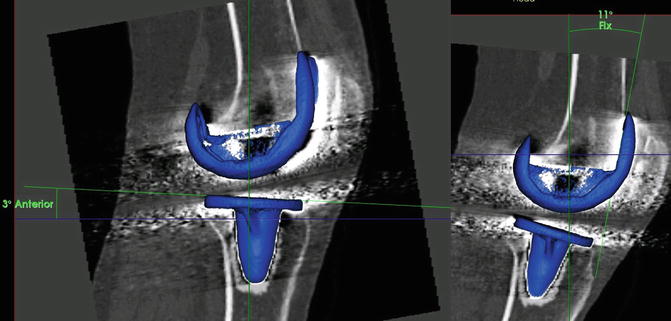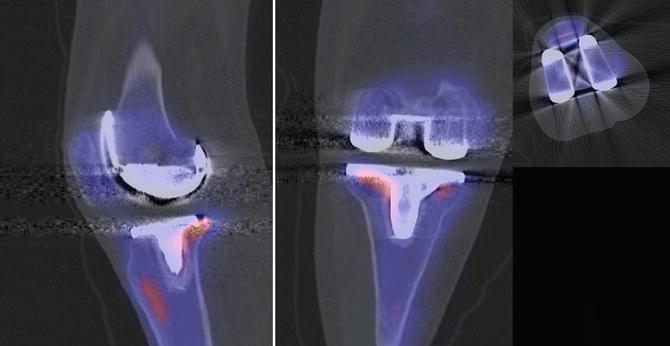Fig. 1
Radiographs (anterior-posterior and lateral) of the right knee showed a posterior stabilised mobile-bearing TKR including primary resurfacing of the patella. The femoral component appeared to be rather large in anterior-posterior as well as medial-lateral dimension
Questions
1.
What is your differential diagnosis now?
2.
What are your next steps in diagnostics?
Analysis of TKR component position in 3D-CT showed a markedly oversized and flexed (11°) femoral TKR component, as well as 3° anterior slope of the tibial TKR component (Fig. 2).


Fig. 2
Measurements of TKR component position using a customised and validated software showed 11° flexion (right) of the femoral TKR component and 3° anterior slope of the tibial TKR component (left bottom)
99mTc-HDP-SPECT/CT showed no increased bone tracer uptake around the femoral and tibial TKR component indicating a well-fixed TKR and no infection (Fig. 3).


Fig. 3
99mTc-HDP-SPECT/CT images of the left knee showing no increased tracer uptake around the femoral and tibial TKR component, indicating a well-fixed TKR and no infection
Questions
1.
What is your diagnosis and proposed treatment?
2.
How would you address the femoral component malposition?
3.
How would you address the tibial component malposition?
The patient’s problems, which are mainly stiffness and pain, can be explained by a too tight flexion gap due to oversizing of the flexed femoral component as well as a slightly anteriorly sloped tibial TKR component.
As causal treatment, the exchange of the femoral component to a smaller size leading to more flexion gap and increased flexion of the knee was identified. It was also decided to combine it with correction of the tibial TKR component position as an exchange of the femoral TKR component, for more than one size is only possible with exchange of the tibial TKR component.
Discussion Points
There are a variety of different factors having significant effects on the range of movement (ROM) after TKR. One can distinguish between patient- and surgery-related factors. The most important patient-related factors are preoperative ROM, algodystrophy, multiple previous operations, trauma history, excessive postoperative pain preventing rehabilitation, anxiety, depression and poor patient self-efficacy [1–4, 6–13]. The most important surgery-related factors are oversized femoral, tibial or patellar TKR components, malposition, infection, improper gap balancing, posterior cruciak ligament (PCL) tightness, instability, anteriorly sloped tibial cuts, prosthesis design and joint line alteration [1–4, 6–13].
When a surgery-related factor is identified as cause of the patient’s stiffness, it clearly increases the chance of success at revision surgery. In patients in which the cause of the stiffness is not clear, at least the exact type of stiffness (e.g. extension deficit, flexion deficit or patellofemoral tightness) needs to be identified [3]. Patellofemoral problems such as patella baja, overstuffing, unresurfaced patella, increased patellar tilt and malrotation of femoral TKR component are the cause of patient’s stiffness in half of the cases [3].
Stay updated, free articles. Join our Telegram channel

Full access? Get Clinical Tree








